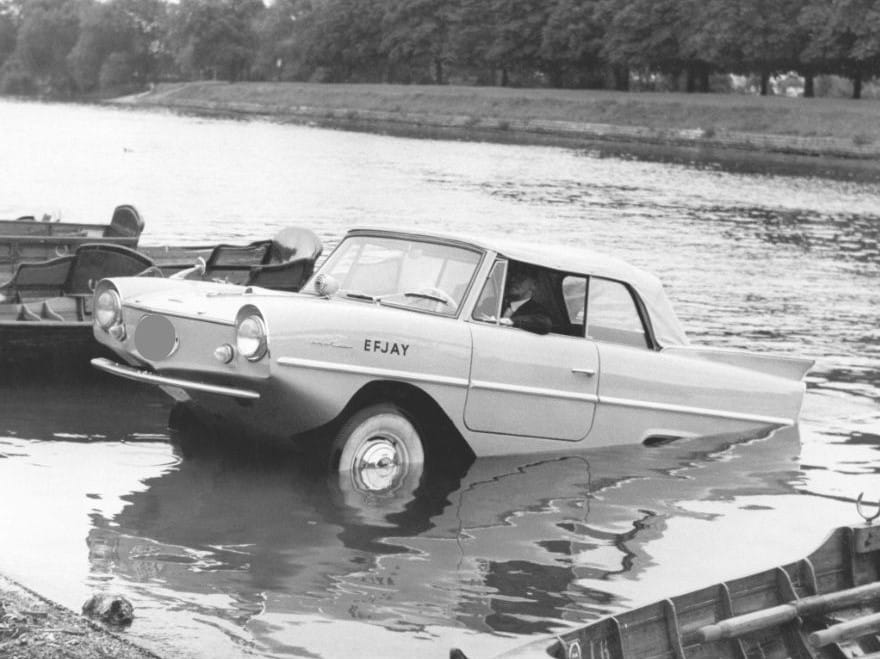Since the dawn of the automotive age, restless inventors and engineers have tried to make a vehicle that would combine different modes of transportation. From an airplane car to a submarine car, history is filled with attractive solutions that weren’t always successful. In fact, most of them never advanced over the prototype stage, yet alone became production reality for various reasons. Mostly since airplane car, for example, is not just too complicated but a pretty dangerous contraption. However, among dozens of failed projects, one reached the customers as a fully-developed production model. It didn’t change the world or our way of commuting, but it offered a very cool alternative to standard roadsters or powerboats. Yes, we are talking about the amphibious Amphicar 770, one of the most fantastic classic cars (or boats) ever made.
The amphibious vehicles were used mostly in the military and had a very big role in WWII. However, they didn’t have any actual use in civilian society after the war. But Hans Trippel, a German industrial designer, had a different idea. He wanted to produce a car that would be ideally suited for cruising on the streets and on the water and being able to switch between those two duties easily. It helped that Germans produced a light amphibious vehicle during the war called Schwimmwagen (swimming car), so Trippel used that as a blueprint and inspiration. Through his connections in the car industry, he managed to interest Quandt Group, a significant German industrial conglomerate that was looking to invest in the car industry. At that time, Quandt Group was preparing to make a big move into the automotive business, and the first step was to produce Trippel’s design. However, a few years later, the Quandt brothers became famous for buying BWM and turning it into what it is today.

So, in 1961, the Amphicar 770 was introduced, shocking car enthusiasts worldwide. It was a fully operational amphibious vehicle, capable of carrying four people in relative comfort on dry land and on the water. The model designation 770 was derived from the car’s top speed – 7 knots on the water and 70 mph on land. Despite the modern contemporary design, the Amphicar had unique construction with a sealed body and two propellers below the rear bumper. The engine was positioned in the back and mounted to the 4-speed manual transmission. On dry land, the car drove just like any other, but when you wanted to go on the water, you needed to switch the drive with a lever and engage the propellers. The engine in the back was borrowed from Triumph 1200, and it was a 1.1-liter, four-cylinder with 43 hp in early models. Even if driving it on the water was as easy as it could be, the user manual suggested that after each cruising, the owner needed to check for leaks and grease all 13 points in order to keep the vehicle in perfect running condition.

The Quandt Group was enthusiastic about Ampicar and anticipated a lot of orders. The Amphicar 770 was offered primarily in the USA with a price of around $3000. Actually, for early ‘60s standards, this was a pretty affordable price, and the Amphicar cost the same as an average family sedan. However, despite the initial interest, the hype surrounding a strange amphibious car soon winded down. The reason was simple. The Amphicar, despite its many talents, wasn’t actually a great car to drive on land and was not that fast or dynamic on the water. With just 43 hp, it wasn’t a performance roadster, and 7 knots wouldn’t classify it as a power boat. Still, in an attempt to promote its abilities, Quandt Group successfully promoted publicity stunts like crossing the English Channel or Yukon River, proving that those little car-boats could handle high waves and harsh conditions.

Due to specific construction, Amphicars developed leaks and rust issues after some use, and many cars ended up underwater. Since it was an amphibious vehicle, the water got inside the bodywork, and eventually, corrosion appeared. Most owners didn’t carefully follow the user manual, which resulted in numerous problems. At the same time, Quandt Group realized that the Amphicar would not be the sales success they hoped for and stopped production in 1963 after just two years on the market. However, the Amphicar 770 was commercially available until 1968, since a number of cars were assembled after the production stopped and sold years after. Most cars ended up on the US market, although a right-hand-drive version produced less than 100 copies. In the end, just 3,878 of the weird but impressive Amphicar 770s were produced in total. Interestingly, some were even used as rescue vehicles.

Despite failing to achieve mainstream popularity, Amphicars had a small but loyal following amongst obscure car fans. The Amphicar enthusiasts organize meets and cruises on land and water and are dedicated to preserving this unique piece of car history. Amongst the famous owners of the Amphicars, there were two well-known names – former US president Lindon Johnson and Hollywood legend Dan Akroyd who had a fleet of them. Today, if you are looking to experience the unique ride in Amphicar, Disney Springs operates several (re-engineered) examples in an amusement park in Florida. As expected, Amphicars achieved solid prices on the classic car market, despite replacing parts and components being hard to come by.





